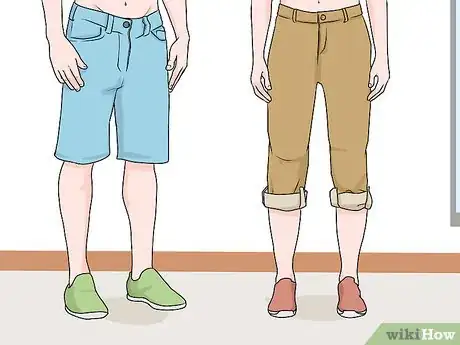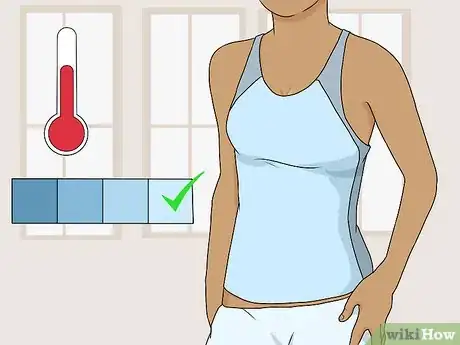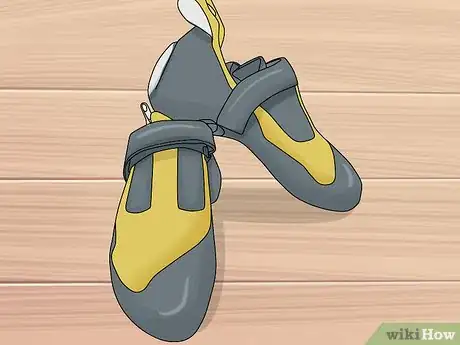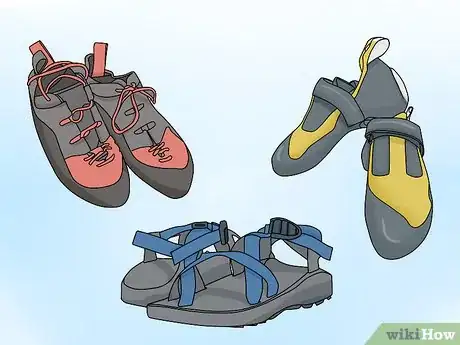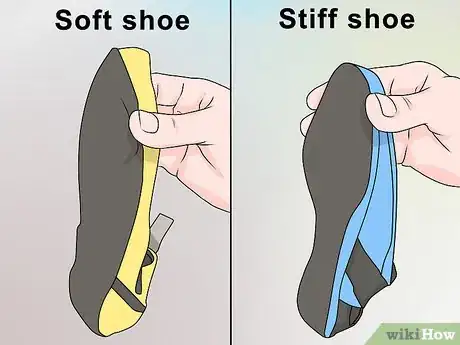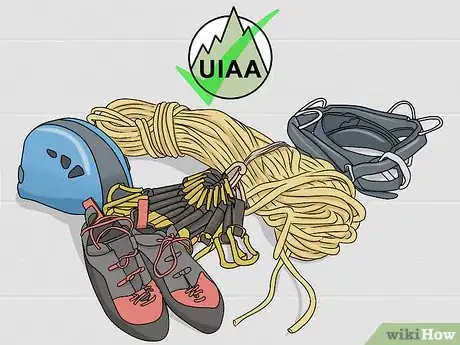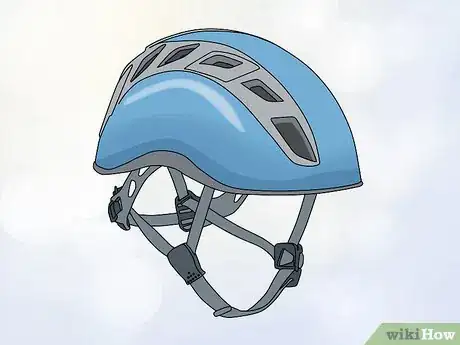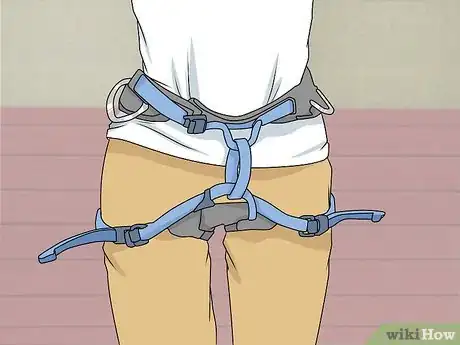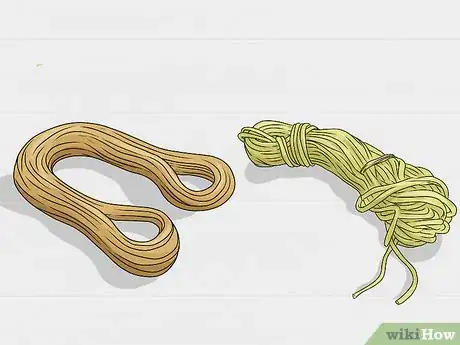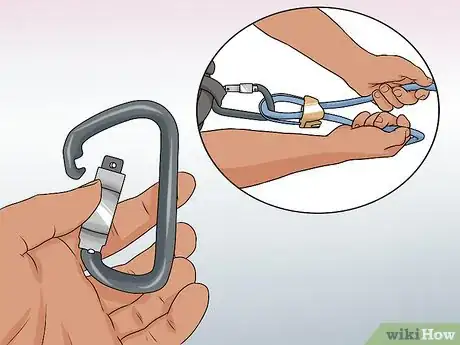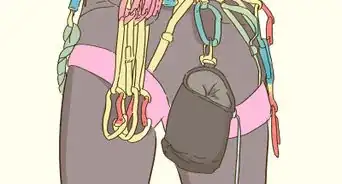This article was co-authored by Erika Noble. Erika Noble graduated from Stanford University with a BS in Management Science & Engineering. After competing in collegiate rock climbing competitions as part of the Stanford Rock Climbing team, Erika worked as a Rock Climbing Instructor in Lake Tahoe. She continues to boulder and climb throughout California and the Southwest.
There are 9 references cited in this article, which can be found at the bottom of the page.
This article has been viewed 60,248 times.
Rock climbing can be a great, tough sport indoors or out. Outfitting yourself right for your climb will improve your experience. It’s important to wear clothes that are loose, comfortable, and protective. If you’re outdoors, you’ll want to dress for the weather. Next, add the right gear to keep you safe. With some good basic clothing and gear, you can really enjoy your climb.
Steps
Putting Your Outfit Together
-
1Wear a loose, comfortable top. Choose a comfortable top that gives you maximum freedom of movement. Consider long sleeves for warmth or to protect you from the sun when you’re climbing outdoors. If it’s really hot, you might prefer a tank top or short sleeves.
-
2Choose long pants for protection. Long pants will protect your knees from scratches and abrasions. This is especially important if you’re climbing in a crack, where your knees will constantly be against the rock. Find loose, comfortable pants.[1]
- Pants can get in the way of footwork so don’t get them too long or too loose.
- Roll up long pants around your feet to be safe.
Advertisement -
3Stay cooler in shorts or capris. Find a good, loose, comfortable pair of shorts, capris, or three-quarter-length pants for hotter days or if you prefer the freedom of movement they provide. Capris and three-quarter-length pants will keep you cooler than long pants while still protecting your knees.
- Wear longer shorts. Your harness will go around your thighs. Longer shorts can protect your thighs from chafing and irritation from the harness.
-
4Get your tops and bottoms in synthetic fabrics. Synthetic materials will wick away sweat and keep you dry. You’ll stay cooler in the heat and warmer in the cold when your clothes are dry. Cotton can stand up better to snags from rocks and will hold up for a long time, but it will soak up sweat, get heavy, and take longer to dry.
- Some go-to synthetic fibers include Tencel, Gore-Tex, nylon, and polypropylene.[2]
-
5Opt for lighter colors in the heat. Wear light-colored clothes on hot days. Light colors will reflect light and heat, keeping you cooler than dark colors. You’ll also be more visible in lighter colors, which can make you safer.
-
6Layer in the cold. Dress in layers in cold weather. Thin layers are better than one heavy layer because heat will stay trapped between layers. You can remove layers as your body or the day heats up. You can also add layers if the day gets colder.[3]
- Start with a warm base layer in synthetic material that will wick away sweat.
- Add an insulating layer for added warmth.
- Top it off with a layer that will protect you from the elements.
- Make sure your clothes are loose enough to give you a maximum range of motion.
Investing in Rock-Climbing Shoes
-
1Find a versatile shoe with a hard rubber sole. Climbing shoes are lighter and smaller than other athletic shoes. Look for a versatile shoe with a hard rubber sole that can handle various kinds of climbs indoors and out. A hard sole can handle all kinds of climbs, will not wear out quickly, and can hold an edge longer than a softer rubber sole.[4]
-
2Get the right fit. All brands are different, so take your time trying them on. A tighter shoe is good for aggressive climbing. Some advanced climbers prefer really tight shoes with their toes bent in the toe box. A softer, looser shoe is suitable for less challenging climbs, climbs with different sorts of pitches, indoor climbing, and for beginners.
- Unlined shoes are more comfortable, but they stretch more so aren’t as durable.
- With a stiff sole you can size up a little for comfort and still be safe on all kinds of climbs.
- Leather shoes will stretch more than synthetics and will gradually conform to your foot. If you choose a synthetic shoe, make sure it fits comfortably when you buy it.
-
3Decide how you want your shoes to fasten. Lace-up shoes are highly adjustable and you can customize how they fit. Velcro shoes are almost as adjustable and are easier to take on and off. This is helpful when your feet get hot or when you’re going between street and climbing shoes. Slippers are the most comfortable style, but they stretch out easily and need to be replaced often.
-
4Choose between a soft or a stiff shoe. Soft shoes will let you feel the rock better and are better for areas with slopes because they stick to the surface better. A soft shoe will not be very supportive, so your feet might get tired more quickly than in a stiff shoe. Stiff shoes let you stand on smaller ledges, but your foot won’t feel the rock as well. A stiff shoe will give your feet more support and prevent fatigue.[5]
Staying Safe with the Right Gear
-
1Buy certified equipment. Rock climbing requires specific safety equipment. Buy equipment that is certified as the most reliable to protect you. The International Climbing and Mountaineering Association (UIAA) has a database of certified equipment that they update regularly. Certified climbing equipment will say that it is UIAA or CEN-approved.[6]
- CEN is the European standard for safety.
- The website for the UIAA database is http://theuiaa.org/safety-standards/certified-equipment/
-
2Protect your head with a helmet. Choose a helmet specifically for climbing. Football and bicycling helmets are not made to withstand rocks and debris that might fall on your head. Pick a helmet with a snug, comfortable fit.[7]
- Choose a helmet with ventilation if you tend to get hot quickly.
- A light-colored helmet will keep you cooler in the sun on hot days.
- Ensure you do not wear a helmet on auto-belays if indoors, or when bouldering.
-
3Look for a comfortable harness. A good-fitting harness will keep you upright when you’re hanging or if you fall. Consider the fit of the waist, legs, and rise when choosing your harness. The waist should be tight enough that you can only fit a few fingers between your body and the harness. You’ll spend more time standing in your harness than you will climbing or hanging, so find one that is comfortable when you stand.[8]
- Harnesses fit around your waist or your hips. You’ll be most comfortable in a harness that fits around your waist if your hips are bigger than your waist.
- The leg straps should not be snug, but not tight.
- The rise is the difference between your waist and your leg straps. You won’t be comfortable if this is too short. Try to find an adjustable rise.
- Mesh harness are the most comfortable, breathable, and lightweight.
- Gear loops should be easy to access. Make sure that they aren’t too far forward so your gear won’t bang on your thighs or get in your way while you climb.
-
4Stock up on rope. Ropes are critical for lead climbing, breaking a fall, rappelling, and even hauling gear. There are several considerations when you choose your ropes. Focus first on length, diameter, and whether your rope is dynamic or static. [9]
- Get rope that is at least 60 feet long. Longer rope will give you more flexibility.
- Ropes come in a variety of diameters. A thicker rope is a safe choice for starting out. It’s also highly durable, locks well into your carabiners, and is easy to grab.
- Dynamic, stretchy ropes are best for lead climbing. Static ropes don't stretch. Both static and dynamic ropes can be used for rappelling and hauling equipment.
- Make sure to check your rope for “dead spots”, or places where the core of the rope feels soft or damaged.
EXPERT TIPErika Noble graduated from Stanford University with a BS in Management Science & Engineering. After competing in collegiate rock climbing competitions as part of the Stanford Rock Climbing team, Erika worked as a Rock Climbing Instructor in Lake Tahoe. She continues to boulder and climb throughout California and the Southwest.PCIA Certified Rock Climbing Instructor
 Erika Noble
Erika Noble
PCIA Certified Rock Climbing InstructorErika Noble, Rock Climbing Instructor, advises: “You want to retire a rope that has dead spots in places where it’s likely you may take another fall. As a rule, flake your rope and check for dead spots before each climb.”
-
5Pick up some carabiners for holding your ropes and for belaying. Choose carabiners that clearly state they are for climbing and are certified to hold significant weight. Carabiners have locking devices and shapes that are specific to the sport. Start by choosing your carabiners based on these two features.
- The D-shape is the most durable, lightweight, versatile, and common. All carabiners will have ratings in kilonewtons (kN) that describe their force-bearing capacity in different positions, including along their spine and across the gate (cross-loaded). A carabiner is most effective when force is distributed along its spine.
- A pear shape has a larger basket to hold the rope and is usually used for belaying (holding the rope to stop another climber from falling).
- Choose between a carabiner that locks automatically when it is shut or one that screws shut (mostly used in wet and icy conditions).
Expert Q&A
-
QuestionWhen should you throw out a climbing rope?
 Erika NobleErika Noble graduated from Stanford University with a BS in Management Science & Engineering. After competing in collegiate rock climbing competitions as part of the Stanford Rock Climbing team, Erika worked as a Rock Climbing Instructor in Lake Tahoe. She continues to boulder and climb throughout California and the Southwest.
Erika NobleErika Noble graduated from Stanford University with a BS in Management Science & Engineering. After competing in collegiate rock climbing competitions as part of the Stanford Rock Climbing team, Erika worked as a Rock Climbing Instructor in Lake Tahoe. She continues to boulder and climb throughout California and the Southwest.
PCIA Certified Rock Climbing Instructor You want to retire a rope that has dead spots in places where it’s likely you may take another fall. As a rule, flake your rope and check for dead spots before each climb.
You want to retire a rope that has dead spots in places where it’s likely you may take another fall. As a rule, flake your rope and check for dead spots before each climb.
References
- ↑ http://www.theactivetimes.com/hike-climb/climbing/rock-climbing-clothes-summer-what-look
- ↑ http://www.shape.com/fitness/clothes/10-fitness-fabrics-explained
- ↑ https://www.thoughtco.com/which-clothes-to-wear-climbing-755629
- ↑ http://www.outdoorgearlab.com/Climbing-Shoes-Reviews/Buying-Advice
- ↑ https://www.ukclimbing.com/articles/page.php?id=3844
- ↑ http://theuiaa.org/uiaa-safety-label/
- ↑ http://boyslife.org/outdoors/guygear/22392/rock-climbing-buying-guide/
- ↑ http://www.outdoorgearlab.com/Climbing-Harness-Reviews/Buying-Advice
- ↑ http://www.climbing.com/gear/2012-gear-guide-how-to-buy-ropes/


